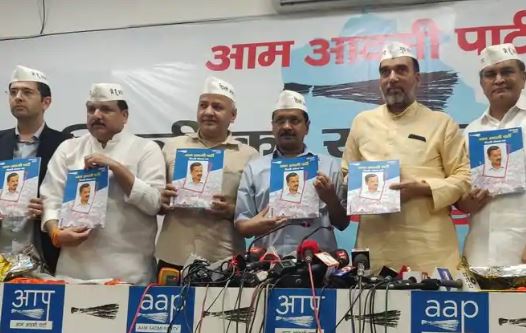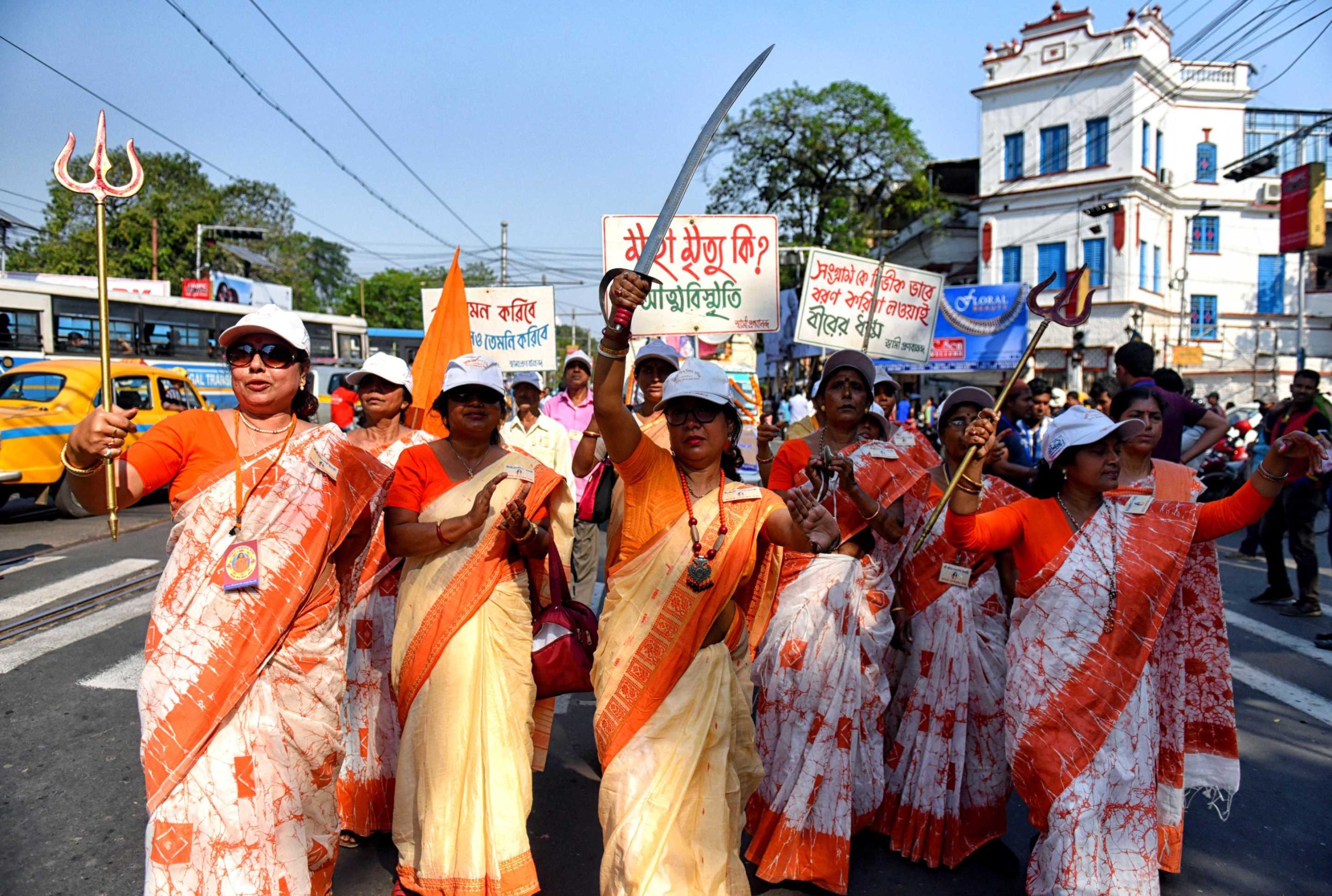On 25th April, the Aam Aadmi Party (AAP) released their manifesto for the 2019 Lok Sabha Elections. At the release, Delhi Chief Minister and AAP convenor Arvind Kejriwal said his party would do everything to stop the “Modi-Shah duo” from coming back to power and they would support any “secular mahagathbandhan” after the Lok Sabha Election.
Kejriwal railed against Rahul Gandhi, the Congress President for failed talks to form an alliance in Delhi between AAP and Congress. “I am saying this with huge sadness that if Modi and (BJP President Amit) Shah return to power, only one person will be responsible – Rahul Gandhi,” Kejriwal told reporters at the manifesto release. Gandhi, on the other hand, tweeted about the possible alliance earlier this month and accused Kejriwal of “making a U-turn” and holding off negotiations.

Back to the manifesto, the 35-page document promises transformation in twelve key areas: Education, Health, Women Safety, Police Reforms, Zero Corruption, Jobs, Land and Housing, Prevention from Sealing, Cleanliness, Pollution, Transport, and Yamuna Rejuvenation. These reforms take up almost all of the manifesto but interlink in a way that forms the subtext of the only point AAP seems to be stressing on, Full Statehood for Delhi. Their tagline on the cover page itself is ‘Le kar rahenge poorna rajya’. It is clear early on that AAP’s political strategy is to demand (and promise) full statehood with little to nothing else.
Also read: Development For Whom?: What The 2019 BJP Manifesto Has To Say
History of Full Statehood (Source: The Quint)
Post-Independence, the States Reorganisation Act, 1956 gave the power to govern the Union Territory of Delhi to Lieutenant Governors who act on the advice of the Central Government. In 1991, Delhi became a special union territory and became known as the National Capital of India. However, the role and powers of Lieutenant Governor (LG) remain unchanged. As a result, Delhi’s elective legislative assembly (at present, AAP) needs the approval of the LG before making major administrative decisions.
The AAP government has no control over two primary bodies in Delhi, the Delhi Development Authority (DDA) and Delhi Police while BJP was elected to run the autonomous Municipal Corporation of Delhi (MCD). Making Delhi a full state would change this and hence, Kejriwal is putting the issue of full statehood for Delhi at the front and centre of his campaign, by linking it to the provision for better education, jobs, housing, safety and security for the people of the city.
It is implied that Delhi’s government has zero powers to tone up their functioning until full statehood is achieved.
In simpler words, India’s capital has two power centres, the elected government and the Lieutenant Governor, who represents the Central Government. These two collectives have been having disputes over power for the past decade or so and blaming the other for all of Delhi’s problems. The BJP manifestos in 1999 and 2014 promised full statehood for Delhi. So did the manifestos of both the Congress and the BJP in 2015. But when AAP passed a bill in the assembly in 2016 to make Delhi a full state, the BJP government at the Centre made no move to approve it.

Does Delhi need Full Statehood?
Each development promise in the Manifesto is divided into two sections, ‘what we did before full statehood’ versus ‘what we will do after full statehood’. It is implied that Delhi’s government has zero powers to tone up their functioning until full statehood is achieved. The manifesto does cover a brief ‘history of the struggle for full statehood’ but it covers just covers AAP’s constant trial for it and BJP and Congress’s negligence.
Ideally speaking, an elected government should have control over the police and development authorities. It would certainly ease and quicken the decision-making process while also keeping accountability undivided. It would reduce the channels of communication thus making it easier for people to approach the government. a line of demarcation will be drawn between New Delhi and Old Delhi which might upset the functioning of these organisations even more than the present red tape.
In reality, however, there are a few problems with Delhi becoming a full state that the Manifesto does not address. AAP has proposed a draft bill which says that “the New Delhi area (under the jurisdiction of New Delhi Municipal Council) which is of national and international importance be kept under the ambit of Central government. The rest of the areas will transition to a full state.” This means a line of demarcation will be drawn between the jurisdiction of Central Delhi and other areas which might upset the functioning of bodies like Delhi Police even more than the present red tape. Read more about MCD’s trifurcation and it’s aftereffects here.
The Delhi Government would need a significantly higher budget in order to take control of these organisations. This could mean higher taxes, excise duties, parking fees etc for the residents. The manifesto does nothing to expand on the source of funds but Manish Shishodia has in the past claimed that Delhi will have enough funds if granted the status of a full state. It would have been helpful then to add these details to the manifesto.
While Full Statehood might help Delhi in the long run, AAP’s promise sounds hollow because of the intense blame game Kejriwal is playing and the power struggle around the issue. Also, AAP would fight for full statehood only if voters elected its candidates from all of Delhi’s seven Lok Sabha seats which is unlikely now that there’s no AAP-Congress alliance.
Other Promises
In his speech, while releasing the manifesto Kejriwal talks about BJP’s Hindutva agenda, “The election of 2019, electing to save the Democracy of India, is the choice to save the country’s constitution.” He said today India’s culture and unity were under attack and that the country could be saved only if people didn’t get divided across religion and caste lines (which would inevitably happen in BJP came to power). The manifesto does not talk about any religious, caste-based minorities and their upliftment at all. The only definition of women’s empowerment for AAP then is safety as there is nothing about other issues that the Womanifesto demanded. There is absolutely no mention of LGBTQIA+ rights and safety which is unacceptable considering the number of crimes against trans people in Delhi.
AAP has in the past criticized both BJP’s and Congress’s manifesto for ‘their false promises’. Although one must not judge a party’s work by their manifesto, I will point out that both these parties have more mention of minority rights than AAP does.
Reserving 85% of the seats for Delhi residents (as the manifesto claims) will be completely unfair, disrupt the notion of merit and will make one of the best educational Institutes inaccessible.
The issues AAP chooses to focus on are then, that Delhi students with more than 60% will get admission into Delhi colleges. Kejriwal has frequented talked about how unfair it is that outsiders take most of the seats in Delhi University completely ignoring the fact that it is a Central University. Reserving 85% of the seats for Delhi residents (as the manifesto claims) will be completely unfair, disrupt the notion of merit and will make one of the best educational Institutes inaccessible.
Also read: Women And Minorities: Here’s What The New Congress Manifesto Has to Say
Other promises include constructing pucca houses for every Delhi family, pollution control, reduce in metro fares etc. It is undeniable that the AAP government has made progress in certain sectors in Delhi, especially in education but one must not view the central theme of full statehood in isolation from the many critiques against it.
AAP leader Gopal Rai had said each of the party’s seven candidates in Delhi will also have a separate constituency-based manifesto. Delhi will vote on May 12. Results will be out on May 23.
Note: The article has been edited to correct the former inaccuracy regarding AAP’s control over the MCD.
Featured Image Source: The Financial Express
About the author(s)
Srishti is a media student at TISS, Bombay. The best compliment she's ever received is "Madam, you write well and all but aap poori zindagi single rahoge"




